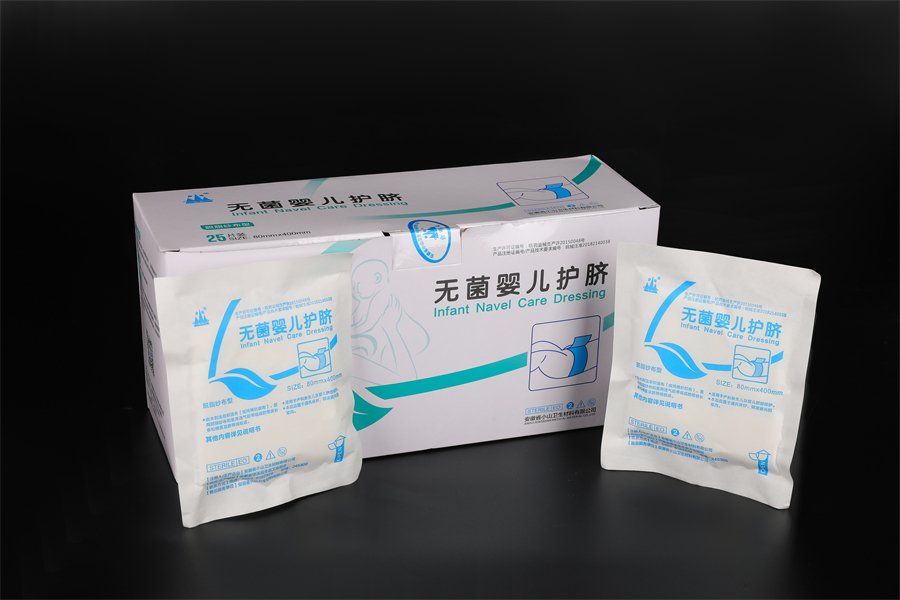Infant navel care dressings are designed with materials that ensure the safe and effective care of a newborn's umbilical cord stump. These materials are chosen for their safety, effectiveness, and ability to promote healing while preventing infections. Here are the commonly used materials in infant navel care dressings:
Non-Woven Fabrics
Polyester: Lightweight and breathable, polyester non-woven fabrics provide a soft, comfortable surface that is gentle on an infant’s delicate skin. These fabrics allow air to circulate, which helps keep the umbilical area dry and promotes natural healing.
Polypropylene: This is a commonly used non-woven fabric in medical applications due to its excellent barrier properties and breathability. It is hypoallergenic and provides a sterile environment that prevents bacterial growth.
Hydrocolloids
Hydrocolloid Dressings: These are composed of a hydrophilic (water-attracting) material that absorbs moisture and exudate from the umbilical stump while maintaining a moist environment that promotes healing. Hydrocolloids are gentle on the skin and help in minimizing the risk of maceration.
Hydrogels
Hydrogel Dressings: Made from a gel-like substance, hydrogels provide a cooling effect and help keep the area moist without allowing it to become too wet. They are effective in reducing discomfort and promoting faster healing by maintaining a balanced moisture environment.
Polyurethane Films
Breathable Films: Polyurethane is commonly used for its breathability and ability to form a barrier against bacteria and contaminants while allowing moisture vapor to escape. This helps in keeping the umbilical area dry and protected.
Cotton Gauze
Sterile Cotton Gauze: Often used in a layered form, sterile cotton gauze is highly absorbent and provides a soft cushioning layer over the umbilical stump. It helps in absorbing any exudate while protecting the area from friction and irritation.
Silicone
Silicone Adhesives: Silicone is frequently used in the adhesive layer of navel dressings due to its gentle nature and non-reactivity with the skin. Silicone adhesives provide secure adhesion without causing trauma during dressing removal, making them ideal for sensitive skin.
Acrylic Adhesives
Hypoallergenic Acrylic Adhesives: These adhesives are known for their strong yet gentle adhesion properties. They are hypoallergenic, reducing the risk of allergic reactions and skin irritation, and are often used in conjunction with other breathable materials to enhance the dressing's performance.
Absorbent Polymers
Superabsorbent Polymers (SAPs): Used in the absorbent core of some dressings, SAPs can absorb large amounts of moisture, helping to keep the umbilical area dry and preventing maceration. They convert absorbed liquid into a gel, preventing leakage and maintaining a clean environment.

Antimicrobial Agents
Silver-Impregnated Materials: Silver is used in some dressings for its antimicrobial properties. Silver ions help reduce bacterial load and prevent infections in the umbilical area.
Chlorhexidine: Another antimicrobial agent used in some dressings, chlorhexidine helps in reducing bacterial growth and protecting against infections.
Foam Layers
Polyurethane Foam: This material provides a cushioning effect and enhances the absorbency of the dressing. It helps in protecting the umbilical area from external impacts and provides a comfortable fit around the navel.
Transparent Films
Polyethylene Films: Transparent polyethylene films are used to create dressings that allow visual inspection of the umbilical stump without removing the dressing. This helps in monitoring the healing process and identifying any signs of infection early.
Elastomeric Materials
Stretchable Materials: These materials, often made from elastomeric compounds, provide flexibility and help the dressing conform to the baby’s body. They ensure that the dressing stays in place even with movement, enhancing comfort and effectiveness.
Biodegradable Materials
Plant-Based Fibers: In environmentally conscious designs, plant-based fibers like cellulose may be used to create biodegradable dressings. These materials are eco-friendly and help reduce the environmental impact of medical waste.
The materials used in infant navel care dressings are carefully selected to balance safety, effectiveness, and comfort. They include breathable fabrics, absorbent polymers, antimicrobial agents, and gentle adhesives, all designed to protect the umbilical stump, promote healing, and reduce the risk of infection. By using these materials, the dressings ensure that the care provided to newborns is both effective and gentle on their sensitive skin.

 English
English 中文简体
中文简体








